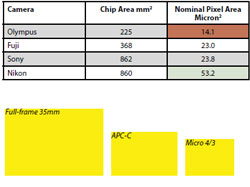articles/Review/compact-system-camera-page4
Arise Compact System Camera! - part 4 of 1 2 3 4 5 6 7
by Mike McNamee Published 10/04/2015
The Pros and Cons
It needs to be stated at the outset that your editor is a 4/3-sceptic! For the reasons outlined below there are fundamental issues with the physics of using small pixels. Despite this there are many successful images being made on CSC cameras (which are not all 4/3 of course) and so they speak or themselves. For balance, therefore, we have included a piece from Sergio Muscat's blog, written in 2013, in which he poses the question as to whether the small format is the way forward. It was a remarkable prescient piece and much of what he says has come to pass, although other things have popped out of the woodwork - Sergio expresses the view that the DSLR has reached the end of the development line but Canon launched a 50 megapixel camera just this week, the medium-format of 35mm form factor! Even so Sergio has produced a delightful exhibition of images for exhibition in Malta just recently. Shot on Olympus, the set are living proof that it's image that matters not the technology!
In addition (and literally hours old!) the arrival of the eight-shot interpolation of the OM E-5 MkII delivers an impressive 40mp file.

Marketing types tend to sell on headline numbers - '64 Megabytes of RAM', '36 megapixels', '5628 dots per inch resolution' - you've all heard them! When it comes to really useful quality parameters such as pixel pitch, effective pixel area and signal-to-noise ratios they fall silent, scared of frightening off the money-bearing punters with too much technical detail. If you don't believe me I was once told when writing a technical book on printing that no graphs or equations could be used - Jacobson, Mannheim and Beck would be wringing their hands in despair (for my part I refused to comply with the wish). Remember though, that no camera is a perfect compromise of weight, cost, size and quality - if it does the job for you it is the correct camera for you, just don't give me your files and ask for a wall paper-size print.
In terms of image quality, and this includes ISO capabilities, noise, dynamic range and pixel cross-talk, nothing trumps big pixels! Bigger pixels gather more photons, produce cleaner (less noisy) signals and have light to spare in terms of ISO. When assessing the intrinsic properties of a Micro 4/3 chip, and APS Size-C and 35mm full frame, the available area for pixels is crucial. Each pixel has to fit in the space allocated but must also have channels all around it to prevent electron cross-talk (effectively electrical signals jumping across the trench to the next pixel column); given the chance pixels are real chatterboxes and cross-talk loses dynamic range and produces blooming. Thus the available pixel area for the Nikon D4s is almost four times that of the Olympus OM D-5, so it is never going to compete in terms of noise and ISO rating. That said, it is horses for courses - your drone might be able to haul a CSC aloft while a DSLR will keep it pinned firmly to the tarmac! If you need to stay quiet and discrete for your own safety, the CSC will bring home your images while the DSLR might come home in your box.
Please Note:
There is more than one page for this Article.
You are currently on page 4
- Arise Compact System Camera! page 1
- Arise Compact System Camera! page 2
- Arise Compact System Camera! page 3
- Arise Compact System Camera! page 4
- Arise Compact System Camera! page 5
- Arise Compact System Camera! page 6
- Arise Compact System Camera! page 7
1st Published 10/04/2015
last update 09/12/2022 14:52:46
More Review Articles
There are 0 days to get ready for The Society of Photographers Convention and Trade Show at The Novotel London West, Hammersmith ...
which starts on Wednesday 15th January 2025





